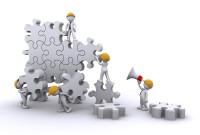- Home
- Business Processes
- Industry Knowledge
- Aerospace Industry
- Automotive Industry
- Banking Domain
- BFSI Industry
- Consumer/ FMCG Industry
- Chemicals Industry
- Engineering & Construction
- Energy Industry
- Education Domain
- Finance Domain
- Hospitality Domain
- Healthcare Industry
- Insurance Domain
- Retail Industry
- Travel and Tourism Domain
- Telecom Industry
- Leadership Skills
- eLearning
- Home
- Leadership Skills
- Leadership Styles
- Tasks & Roles of Leadership
Tasks & Roles of Leadership
What are the functions which a leader does to establish as a leader? What are the activities undertaken by them to become great leaders, rather revolutionary leaders? The most important tasks done by a leader in all situations are defining the vision, mission, and goals, leading the team, administrative functions, motivating followers, decision making and conflict resolution, and continuous development.
Let us now look into other functions and activities of leaders. To a large extent, the functions and activities of leaders are contingent upon the situation in which leaders work and they are found to vary with a number of factors.
Leadership is quite important for an organization and they act as agents who cope with change and bring about change for the betterment of the organization. Leadership is a highly complex and elusive trait. Leadership is one of the most effective tools of management and organizational effectiveness depends on the quality of leadership. There major factors that define leadership are influence/ support, voluntary effort & goal achievement. Some of the common activities and functions are mentioned below:
1. Define Vision & Mission
Leadership is the process of influencing and supporting others to work enthusiastically towards achieving organizational objectives. A leader helps the team or team member identify its goals and then motivates and assists in achieving the stated goals.
Leaders establish vision and mission and set the direction for the organization, communicate the vision to the people in the organization and synchronize them with the organizational vision and mission, thereby inspire the people to translate the goals, vision, and mission into reality.
Interestingly, Peter F Drucker feels that it is neither charisma nor personality traits nor qualities which guarantee effective leadership. He feels, what distinguishes effective leadership is, thinking through the organization's mission, defining it, and establishing it, clearly and visibly. The leader sets the goals, priorities, and sets and maintains the standards.
It requires vision, courage, understanding, determination, decisiveness, sense of timing, capacity to act, ability to inspire, etc. Leadership is the ultimate act that brings success and innovation and explores the capabilities and potential of the organization and its people. Inspire a shared vision and establish standards that help the organization or group achieve its next stage of development. Exert influence outside the group in order to set the right context for the group or organization
2. Team Leadership
A team is a collection of people, often drawn from diverse but related groups, assigned to perform a well-defined function for an organization or a project; team members always share some responsibility towards the realization of the goals. Thus leaders always need to ensure their members train as a team. This also means an equal opportunity for all.
A leader acts as a surrogate for the individual responsibilities of his or her subordinates. A leader takes care of the team members by making adequate provisions to satisfy their personal and professional needs and interests so that members work for facilitating the sustainability of the group. A leader serves as a model for others to emulate and functions as an ideologist. As a father figure, a leader serves to fulfill an emotional role for the members of the group.
He tries to maintain the high morale of the group members for better performance. The most important function of a leader is to work towards unity and cohesiveness of the group and to see that members have a pleasant satisfying experience. Suggesting often permits the subordinates to retain dignity and a sense of participation. A leader defines and supplies objectives that will allow members to work together.
In fact, we can say that in every group every member bears some relation to the others, and all of them influence and affect each other. When an individual behaves in ways that others in the group/ organization believe will help them achieve desired goals, that individual is seen as a leader and is perceived to possess certain attributes. The leader facilitates the development of cohesiveness and cooperation among people at work.
Leaders not only are required to encourage, upgrade, and promote deserving workers but also to disapprove, transfer, and fire poor workers. A leader provides; a ready target for the aggressions of the members of the group. Foster unity, collaboration and ownership, and recognize individual and team contributions. Exercise power effectively and empower others to act
3. Administrative Functions
Leadership is equated with management. Leadership handles, people, institutions, and works for achieving the targeted goals as management. Many of the functions of leadership are similar to the functions of management.
As mentioned earlier, in addition to above the common functions and activities, a leader also carries many of the managerial functions like planning, executing, policymaking, coordinating, and controlling. All the managerial functions are applicable and a majority of them are carried out by formal leaders. Goal setting: A leader contributes significantly to establishing the goals and objectives of the organization. Executing: As a manager, a leader not only contributes to planning but also takes responsibility for executing the plan Expertise: A leader is supposed to be an expert in the principal activities of the organization.
A leader also performs the functions as an executive, planner, decision-maker, expert, referee, and peacemaker. A leader is expected to set goals (sometimes the goals are set by the management), organize the structures and design programs to accomplish the goal, make policies and give guidance and directions to the subordinates. Procure, manage, and allocate resources and monitor progress, solve problems, and maintain discipline.
Represent the organization at different forums. A leader as a representative serves as a symbol of the organization and speaks for the organization, clarifies the organization's position, and hence compels outsiders to think of the whole organization in terms of their impression of the leader. In essence, he/she represents the organization.
4. Motivate & Inspire
Leadership is a process by which a person influences others to accomplish an objective and directs the organization in a way that makes it more cohesive and coherent. Leaders carry out this process by applying their leadership knowledge and skills.
Leaders stimulate and inspire employees as individuals and group members and motivate them to make their optimum contribution to organizational efficiency and effectiveness. The leader reflects on the relationship among events and quickly grasps the meaning of complex issues. The leader willingly assumes a higher level of duties and functions within the organization.
Two major ingredients for the skilled art of leadership are the ability to use appropriate motivators and the ability to inspire. This is very obvious if we look into the reasons for such a few subordinates working with continuing zeal and confidence. Motivators are concerned with man's need for identity and stimulation and appear to be centered about the subordinate and his/her needs, whereas to inspire, depends on the rate ability of a leader and inspiration emanates from him/her. Inspiration depends on the charismatic qualities of a leader. Often, the inspirational ingredient in leadership is likely to lie dormant, only to become a potent art in times of crisis. Hence the fundamental principle of leadership is "since people tend to follow those in whom they see a means of satisfying their own personal goals, the more a manager understands what motivates his/her subordinates and how those motivations operate, and the more he/she reflects this understanding in carrying out his managerial actions, the more effective as a leader he is likely to be".
Theories and knowledge about people and their motivations can be taught but plans of action based upon this knowledge are largely a matter of art. The inspirational ingredient as a dynamic process is even less amenable to teaching and the techniques vary with circumstances and with the people involved.
Appreciating the works of the subordinates, a leader inspires them to enthusiastically accept organization goals and contribute more towards goals. To recognize that people differ in their motivational pattern. The leader creates an environment where others want to do their best. To create an environment that produces convergence of individual goals and organizational goals. Having the interest of workers sincerely at heart a good leader pats them for their good work.
5 Decision Making & Conflict Resolution
A leader is often involved in arbitrating and mediating with his subordinates, other teams, and leaders or external parties. He works towards resolving the disagreement by arbitrating or making the decision on the course of action to be taken. A leader acts as a catalyst and inspires subordinates into action, he acts as a force that is required to start or accelerate the movement. To make sense of changing environment, interpret it to employees, and redirect their efforts to adapt to changing situations.
The use of good problem solving, decision making, and planning tools add to the leadership qualities of an individual. A leader provides some sort of personal security to workers by maintaining a positive, optimistic attitude even in the face of adversaries.
6 Self and Team Development
A leader must establish an environment conducive to learning. Satisfy the work-related needs of the members of the group as individuals. Create a conducive or favorable climate for the personal and professional growth and development of team members. Further, a leader may have to cultivate several attitudes and qualities including empathy, objectivity, self-knowledge, identity, authenticity, open-mindedness, independence, responsibility, reason, concern for others, zest for life, energy, maturity, courage or guts (moral and physical), a strong sense of obligation, clarity of mind, integrity, vision, etc.
Related Links
You May Also Like
-
Many different types of teams have been identified by social scientists. Managers may encounter the diverse types of challenges while managing different kinds of teams. Challenges associated with Cross-Functional Teams might be different from that of a Geographically Dispersed Team or a Virtual Team. This article explores some common categories and subtypes of teams.
-
There are four major factors in leadership called Leader, Follower, Communication, and Situation. The success of the leader is dependent on how the leader is effectively able to communicate and motivate followers to perform desired tasks using the appropriate leadership style best suited for the given situation. Interdependencies and dynamics of these four factors of leadership must be considered by a leader to be effective.
-
Principles of management are fundamental concepts and advisory guidelines for managerial decision making. By using management principles, managers can more easily achieve the objectives and avoid making mistakes in their activities. Management principles can be applied to any kind of organization and to managers at all organizational levels.
-
Frederick Winslow Taylor started the “Scientific Management Movement”, and attempted to study the work process scientifically. Scientific management, also called Taylorism, was a theory of management that analyzed and synthesized workflows. It is a system for increasing the efficiency of manpower to its maximum potential and streamlining production to improve efficiency. This article explores this theory in more detail.
-
There are four characteristics of leadership that help us to understand the character of leadership as a concept. 1. Leadership is a process, 2. Leadership involves influence, 3. Leadership always occurs in a group context and 4. Leadership involves goal attainment. These are the four components that make up the character of the 'leadership' term and help us to define the leadership concept. All of these components of leadership have common characteristics.
-
All the teams are dynamic in nature and they take time to come together, they form, develop, and grow in stages, over a period of time. Teams go through five progressive stages: Forming, Storming, Norming, Performing and Adjourning. In this article, we want to introduce you to these stages of team development and certain strategies that you can use to help the team grow and develop in each of these stages.
-
Teams are part of the modern organizational culture. Whether you are a team leader or a team member, having a better understanding of how teams work, and being able to identify where the team is in the process, is a critical part of ensuring the team is ultimately successful. Start with the basics and understand what a team is and what role they play in an organization.
-
Quantitative Theory of Management
The quantitative management approach is given by the mathematical school that recommends the use of computers and mathematical techniques to solve complex management issues and assist in the managerial decision-making process. Managers observe historical quantitative relationships and use quantitative techniques such as statistics, information models, and computer simulations to improve their decision making.
-
Management theories are the recommended management strategies that enable us to better understand and approach management. Many management frameworks and guidelines were developed during the last four decades.
-
In its simplest sense, decision-making is the act of choosing between two or more courses of action. Decision making is a key skill in the workplace and is particularly important if you want to be an effective leader. When decisions have to be made, there are several stages that you should go through to reach a practical solution. Understand the meaning and importance of decision making and how to look at it as a process.
Explore Our Free Training Articles or
Sign Up to Start With Our eLearning Courses

About Us
Learning
© 2023 TechnoFunc, All Rights Reserved










